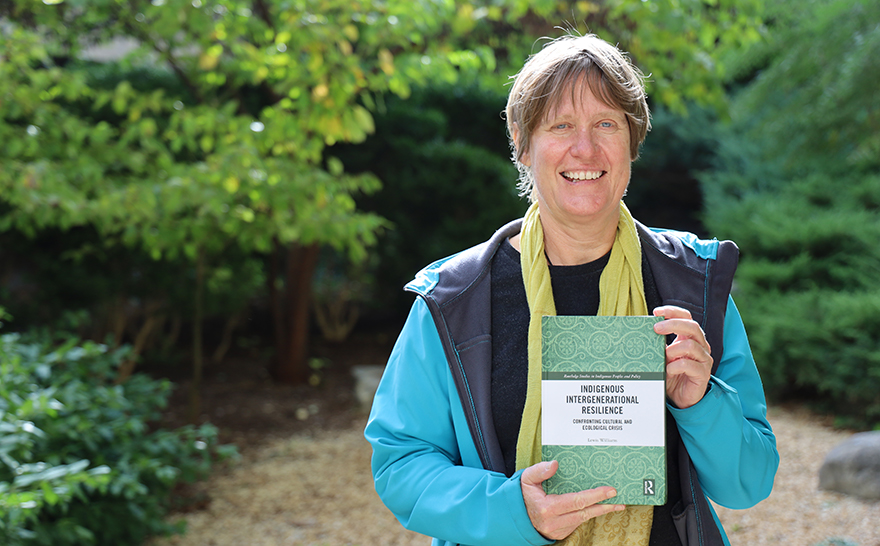News and Updates
Contact
Faculty of Social Science
Social Science Centre
Room 9438
Western University
T. 519-661-2053
F. 519-661-3868
E. social-science@uwo.ca
Solving the world’s problems through Indigenous connections
November 02, 2021
Photo and story by Rob Rombouts
The world is in crisis – climate change, a pandemic, social and economic disparities, and an increase in white supremacy activities – and these problems are rooted in displacement and disconnection from place, and addressing them requires Indigenous-led, intergenerational resilience.
This is the premise of Lewis Williams’ new book, Indigenous Intergenerational Resilience: Confronting Cultural and Ecological Crisis.
Williams, a professor in the department of geography and environment and Indigenous Studies, said the work is “about inclusive approaches to intergenerational resilience, that centre on Indigenous realities, knowledge-systems and peoples.” Intergenerational resilience focuses on bringing together experience of Elders and traditional knowledge keepers and contemporary experiences of youth. The book, which is set in Aotearoa and Turtle Island, also narrates Williams’ own story of connecting to the Ngāi Te Rangi part of her identity.
“Many of us are a mix of different cultural lineages. Most people have lost connection with place,” said Williams, who is of Māori, Scottish, Welsh and German ancestry.
White-presenting, Williams grew up in urban Aotearoa disconnected from her ancestral lands. In response to her own grief and disconnect, Williams spent much of the past two decades actively reconnecting with her iwi or tribe, including learning the language of her people (te reo Māori) and living on her traditional territory for several years. Living on Indigenous lands across different parts of Turtle Island has also given her experiences of deepening into place as a settler-migrant.
Reconnecting to Indigenous ways
Centering Indigenous leadership includes learning about the everyday realities and knowledge of peoples indigenous to an area and respecting the relationships that exist between the Indigenous peoples and the space they are indigenous to. Williams contrasts this to white supremacism – a worldview and set of structures based on reductionist, hierarchical and binary ways of thinking. At its most visible, it manifests as violence imposed on Black bodies and Indigenous lands, but ultimately it is about the power, privilege and patterns of thinking associated with, but no longer exclusive to, white people.
“White supremacism however, is not confined to white bodies,” said Williams. “Nor is the book’s message that people who have white skin reflect white supremacism.”
White supremacy can also be displayed through the internalization of this worldview by Indigenous peoples, although with different results, because it is not tied to material power relations in the same way, she said.
“Think, for example,” said Williams (who identifies as Takatāpui/member of the rainbow community) “about the ways in which western hierarchical and dualistic ways of being have attempted to stamp heteropatriarchy and binary sex/gender onto Indigenous societies. By enforcing this view, traditional, earth-centred ways of being in which all of creation is valued as carrying distinct gifts, are discouraged or forgotten. This leads to displacement, disconnection and lack of consideration for others and the environment.”
‘Dig where you stand’
Through the book, Williams tells stories and highlights work that are underway to connect people to Indigenous ways-of-knowing. One chapter, set in Toronto, discusses a project she co-led aimed at engendering healing and a deeper sense of belonging for immigrant and refugee women by partnering with an Indigenous organization and affiliated communities. Another chapter looks at Rongoā Māori, Māori systems of medicine and healing, and kiatiakitanga (care for the environment) as a generative response to climate crisis, displacement and ecological damage.
Williams does not consider relations as a dichotomy between Indigenous and non-Indigenous, but rather one of Indigenous, and those who are no-longer indigenous to place. “We have to “work” the paradox of simultaneously addressing huge cultural and material power disparities while digging down underneath identity politics to fundamental issues of epistemology,” she said.
“All people’s ancestors have once been indigenous in place,” she said. “We have that capacity to reconnect to place. I’m not saying that people who are from another place can become Indigenous or can become the Indigenous peoples of an area – but they can come to understand the Indigenous ways of being, those laws, in ways that are culturally situated and relevant.”
Through this approach, Williams wants to provide people with new frameworks for Indigenous resurgence and reconciliation.
“A multi-generational approach is critical – each generation has its unique perspectives and gifts. Today it’s easy to feel overwhelmed. A good starting point is to dig where you stand. For example, learn the local Indigenous history, the place names, the language, get to know the land and her rhythms. Find ways to learn the Indigenous legal laws in ways that are not taxing for local Indigenous peoples,” said Williams.
“If you do have Indigenous ancestry to Turtle Island, but are disconnected, if you can, go back and connect with your people. Importantly, consider how you can become part of the return of Indigenous lands to Indigenous Peoples. Connect. Connect. Connect. For we are all in this waka/canoe together.”

